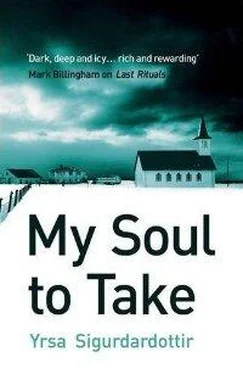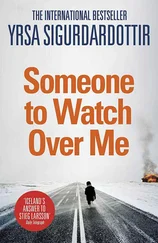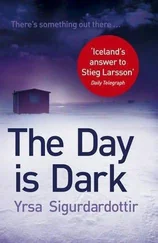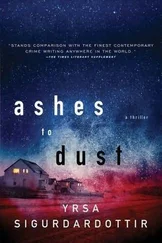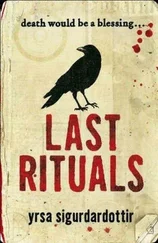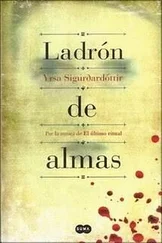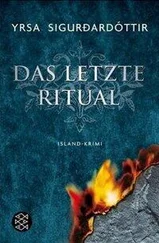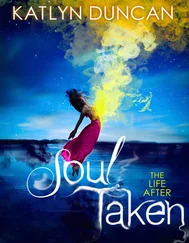“Look,” Thóra said, “there’s the cemetery.” A few graves could be seen at the far end.
“Fewer people must have died here than they were expecting,” Matthew said, surveying the expanse of ground between the church and the gravestones.
“Yes,” Thóra said. “That’s odd. Vigdís said the church still served the local community, so it might fill up over time.”
“Seems unlikely,” said Matthew. He went up to the church door and examined the lock. “What am I supposed to do again? Push or pull?”
“Push, I think. Or pull. One of the two,” Thóra said vaguely. Instead of watching Matthew, she scanned the cemetery and gravestones. “Do you think we’ll find Kristín’s grave?” she said, turning back to Matthew. He was struggling furiously with the door. “Birna must have been looking for it when she was here.”
“I don’t know,” he snapped. “I’m more concerned with opening this bloody door.” He pressed one shoulder against the wood and turned the key. A soft click was heard. “Na endlich!” he said proudly, and pushed the door open. “Bitte, Frau.”
The vestibule would have held four people at the most. It led to the nave with an altar, pews, and pulpit. Most of the interior was timber, painted in soft colors and embellished with flower patterns around the edges of the ceiling and along the pews. The overall effect was neat and cozy, with the exception of the altarpiece showing Christ’s crucifixion on Calvary.
“Why are these pews so small?” asked Matthew, trying to sit down. His backside hardly fit on to the bench, and the one in front left no leg room.
“I bet it’s to make sure you don’t fall asleep,” Thóra replied. “Or to save space. Actually, that’s a more likely explanation.”
“Unless the Icelanders used to be a nation of dwarves,” said Matthew, standing up. He walked over to where Thóra stood, by the stairs up to the balcony. “Should we have a look up there?” he asked. “I reckon we’ve seen everything down here in the fifteen seconds we’ve been here.”
They went up the narrow stairs and on to the balcony. Everything was painted in the same subdued colors. There was a good view over the nave from the handrail and for the first time Thóra noticed a brass chandelier in the middle of the ceiling. They looked all around, but there wasn’t much to see: just an impressive organ with an open book of sheet music on it and a wooden chest that turned out to contain hymn books and other choral paraphernalia. There was nothing else on the platform.
“That was a waste of time,” she said, disappointed. “I expected something much more exciting.”
“Like what?” Matthew asked. “There won’t be anything connected with the murder here. Birna was just excited about the building. She was an architect, after all.”
Thóra frowned, unconvinced. “Shouldn’t there be some kind of storage room here? Surely the ministers don’t have to lug everything to the church and back when they come here for the service.”
Matthew shrugged. “There’s a Bible on the altar. Maybe that’s enough for them. And a couple of candlesticks.”
“What about church records? Aren’t all churches obliged to keep records?” Thóra went back to the handrail for a better view of the church. Maybe there was a cupboard or box cleverly hidden away somewhere, though she couldn’t see anything to suggest that. “They have to record everything that takes place here.”
Matthew regarded her quizzically. “What do you mean?”
“Weddings, christenings, confirmations—it’s all written down in the church records.” Crossing to the wall at the far end of the balcony by the stairs, Thóra walked along it hoping to find a hatch. “I knew it!” she shouted excitedly, spotting a rectangular hatch on the ceiling above. “There’s something up there.”
Joining her, Matthew looked up. The ceiling was low, so he had no trouble opening the hatch. They both looked up into the dark hole. “I think I can see steps,” he said. “We need more light.”
Thóra flicked an old-fashioned switch by the stairs and a few wall lights came on. “Is that better?”
“Yes and no,” he said. “It’s better in that I can see, but worse in that I can see there’s nothing there.”
“Nothing? No books?” asked Thóra disconsolately, craning to see inside.
“No,” replied Matthew. “It’s just for access to the steeple, as far as I can tell. I doubt any books are kept there.” He grabbed the edge of the opening with both hands and heaved himself up. “No, there’s definitely nothing here.” He lowered himself to the floor and clapped his hands to brush the dust off them. “Maybe Vigdís knows where the church records are kept. She has the keys, so who knows, maybe she’s been put in charge of stuff like that.”
“I’m just going to have a closer look at the altar,” Thóra said. “It must be here somewhere.” They descended from the balcony, and she walked ahead of Matthew toward the suffering Jesus. A cursory glance revealed only the Bible and two large candlesticks. They sat on a table covered in a beautifully embroidered purple cloth, against the far wall beneath the altarpiece. Lifting the cloth, she saw that the table was in fact a small cupboard. “Matthew, look,” she called. She bent down and took hold of the recessed handles. Fortunately the cupboard was unlocked and the doors opened with a soft creak. Thóra beamed triumphantly over her shoulder at Matthew and took out three large leather-bound books.
The top one looked quite new, and when Thóra opened it, she knew she needn’t waste any time examining it: the date on the first page was 1996. She opened the next book and flicked through it until she found a date around 1940. “I think Kristín was here during the war,” she said to Matthew. “The film-star photos I found under the rafters were from then.” She flipped through the whole section, but found nothing. There were several births, christenings, marriages, and deaths, but no Kristín was to be found anywhere.
There was something strange about the entry for 1941, where the left-hand page ended with the name of a bride but the page facing it appeared to refer to a funeral. “That’s odd,” she said, opening the book wider and examining the join in the center. She handed it to Matthew. “Look,” she said, “a page has been removed. Maybe two.”
Matthew examined the book and nodded. “You’re right,” he said, passing the register back to Thóra. “Bizarre. Who would do such a thing? Someone who wanted to erase a wedding?”
“Or someone who wanted to erase a child’s christening,” Thóra said. “If you erase the birth records of a child born in that era, you’ve pretty much succeeded in wiping out every trace of it. I don’t know whether the national registry had been established by then, and even if it was, we can’t know whether it was used properly in rural areas. It can’t have been too difficult to keep yourself, or someone else, outside the system.”
They replaced the books after Thóra had searched through them all with no sign of Kristín.
Outside in the cemetery, they didn’t need to walk past many graves to appreciate how much times had changed. Most of the graves in the tiny cemetery bore inscriptions like “Boy—stillborn” or “Girl—unchristened.” More often than not, several children of the same parents lay side by side, or one gravestone served a group of siblings. Thóra carefully examined every inscription in the hope of finding names she recognized. She found two graves whose headstones bore the name Kristín, but both occupants had died in old age. She thought it unlikely that these women were connected with the inscription under the rafters.
Eventually they came to two neighboring plots separated by a low fence. Both had particularly large and impressive headstones, at least five feet high and carved from pale stone. Orange moss or lichen had spread across them. The carving on one showed a snake curling around to bite its tail, along with an oil lamp. Thóra recognized neither symbol, but she remembered that there was a lamp on the cover of the Gideon Bible. She asked Matthew whether the images meant anything to him, but they didn’t. She read the inscription, which bore the names of the family from Kirkjustétt, the farm that was now part of Jónas’s hotel. At the top was the head of the household: “Bjarni Thórólfsson, farmer from Kirkjustétt, b. 1896 d. 1944.” Beneath it stood “His wife, Adalheidur Jónsdóttir, b. 1900 d. 1928.” Two more names were inscribed below: “Bjarni b. 1923 d. 1923” and “Gudný b. 1924 d. 1945.”
Читать дальше
